Do you struggle with pests in your garlic? Are you unsure of how to handle diseases in your diseases in your garlic? This post outlines the basics of garlic and harvesting garlic, and how to identify and handle the pests and diseases in your garden.
Garlic is a low-maintenance, perennial plant in the onion family. Garlic is closely related to leeks, shallots, chives, and onions. Across Halton Region and Southern Ontario, garlic cloves (with sheath) are planted in the late fall and harvested in late June or early July. It is important to plant garlic before the first frost.
There are two main varieties of garlic: softneck and hardneck. The hardneck garlic variety produces garlic scapes, which can be harvested and used for cooking. The softneck garlic variety do not produce garlic scapes and often have multiple smaller cloves per bulb.
You can learn more about garlic by visiting our IGTV channel and watching our videos on harvesting garlic and harvesting garlic scapes.
A pest is an organism that is harmful to your plant. Pests often latch onto plants and sometimes makes the plant unsuitable for harvest. Each and every garden is susceptible to pests.
A disease is a disturbance to the plant caused by living (biotic) and non-living (abiotic) agents, or pathogens (such as fungi, bacteria, viruses, mycoplasms, etc.). Diseases, similar to pests, can make the plant unsuitable for harvest.
Garlic is a hearty plant; however, it can still be affected by various pests and diseases. The most common pests and diseases that affect garlic in Ontario are the Leek Moth, Fusarium Basal Plate Rot, Penicillium Mould, Onion Maggot, and viruses.

Leek Moth
The Leek Moth is an invasive species from Europe that can affect your garlic crop. The adult lays eggs on the garlic leaves, and the larvae tunnel into the stems. This tunnelling will create pinholes in the garlic leaves that can leave your plants susceptible to other diseases. Leek Moth larvae cause damage to the garlic leaves; however, they often do not affect the bulb. To prevent Leek Moth in your garlic, plant garlic late in the season, practice crop rotation, and use row covers.
Fusarium Basal Plate Rot
Fusarium Basal Plate Rot is a soil borne pathogen that invades the roots and basal region of the garlic plant. It affects the roots, which results in yellow leaf tips and dieback of the shoot in the spring. It is also common for the basal region to become pink due to the growth of fungus. This pathogen thrives in warm, damp soil. To prevent Fusarium Basal Plate Rot, it is important to practice crop rotation in your garden.


Penicillium Mold
Penicillium Mold is the primary cause of decay in stored garlic. It appears as the blue-green growth at the base of the garlic bulbs. It is important not to plant cracked garlic cloves with no papery sheath, as the primary source of the mold spores are diseased bulbs. Pathogens, such as Penicillium Mold, thrive in warm soil temperatures. To prevent Penicillium Mold, wait until temperatures are cooler before planting.
Onion Maggot
Onion Maggots are another pest that can have detrimental effects on garlic and other plants in the onion family. The pupae remain in the soil over the winter season, and in the spring, they develop into adults, which look like the common housefly. In one season, there can be three generations of Onion Maggots. The evidence of Onion Maggots is seen in mid to late June through wilting and then rotting of the stems. It is important to remove and dispose of all traces of infected plant and harvested material (do NOT compost it).


Viruses
There are a range of viruses that can affect your garlic crop. Some viruses do not damage the bulb unless the bulb is stressed (likely due to lack of water or nutrients). A garlic plant affected by a virus may have mosaic look to the leaves, streaking, or mottling of the leaf colour. To prevent viruses in garlic, monitor your garlic crop closely and destroy any infected plant material.
For more information on the pests and diseases that affect garlic, check out our recent IGTV video on our Instagram channel.
Questions? Please email us at .
Contributed by Alicja Jazwiec, Community Garden and Education Assistant.
References:
OMAFRA. (2009). Garlic Production. http://www.omafra.gov.on.ca/english/crops/facts/09-011w.htm
OMAFRA. (2009). Leek Moth – A Pest of Allium Crops. http://www.omafra.gov.on.ca/english/crops/facts/08-009.htm
OMAFRA. (2009). Onion Maggot Control. http://www.omafra.gov.on.ca/english/crops/facts/00-017.htm
OMAFRA. (2016). Fusarium basal plant rot. http://www.omafra.gov.on.ca/english/crops/hort/news/hortmatt/2016/14hrt16a1.htm

